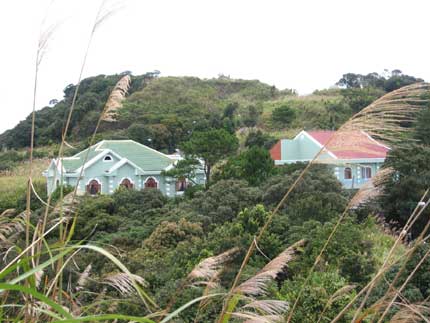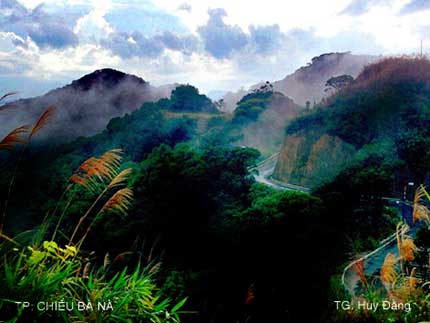Ba
Na -Nui Chua Nature Reserve

Alternative site name(s)
Ba Na
Province(s)
Da Nang City
Area
38,210 ha
Coordinates
15°57' - 16°08'N, 107°49' - 108°04'E
Distance(s)
From Da Nang City
From Hue City
Eco-tours
Available. Contact
us for more information
Topography and hydrology
Ba Na-Nui Chua Nature Reserve is centred
on Mount Ba Na, a 1,487 metre-high mountain
on the border between Da Nang city and Quang Nam province.
Mount Ba Na is situated to the south-east of the mountain
ridge that stretches across central Vietnam, from the Annamite
mountains to the Hai Van pass. However,
Mount Ban Na and the montane habitats it supports are isolated
from this ridge by intervening areas of lower elevation.
Streams and rivers originating in the north-west of the
nature reserve feed the Ca De river, which flows into the
north of Da Nang bay, while those originating in the south
and east of the nature reserve feed the Yen river, which
flows into the south of the bay.

Biodiversity values
The main natural vegetation types present at Ba
Na-Nui Chua Nature Reserve are lowland evergreen
forest and lower montane evergreen forest. The lowland evergreen
forest is characterised by the presence of tree species
in the Dipterocarpaceae family, which are absent from the
lower montane forest. The lower montane evergreen forest
is dominated by species in the Lauraceae, Fagaceae and Podocarpaceae
families. Areas which have been cleared of forest support
secondary vegetation. The summit of Mount Ba Na was cleared
of forest by the use of herbicides during the Second Indochina
War and now supports grassland.
543 species of vascular plant have been recorded at Ba
Na-Nui Chua Nature Reserve. These include 12 species
listed in the Red Data Book of Vietnam:
including Dalbergia cochinchinensis, Decussocarpus fleuryi,
Melanorrhoea usitata and Dipterocarpus grandiflorus.
61 mammal species, 178 bird species and 17 reptile species
have been recorded at Ba Na-Nui Chua. Many
of the species listed in the investment plan were also recorded
during surveys by Frontier-Vietnam in 1994 and 1995, which
recorded 472 vascular plant species, 29 mammal species,
106 bird species, 20 reptile species, six amphibian species,
33 fish species and 126 butterfly species. Further survey
work is required, however, to determine the current status
of species of conservation concern at the site.
Other documented values
The forest at Ba Na-Nui Chua Nature Reserve
protects the watersheds of the Ca De and Yen rivers. These
rivers are an important source of water for irrigation,
and domestic and industrial use in Da Nang city.
In 1919, the French colonists established a hill station
at the summit of Mount Ba Na. In recent
years, a tourism resort has been re-established at the site,
with hotels, guesthouses, a cable car and a road to the
summit of Mount Ba Na.
The 8,838 hectare Ba Na natural preservation area has 8,800
hectares of forests and forestry land, including 6,942 ha
of afforested land (5,976ha of natural forests and 966 ha
of planted forests) and 1,858ha of treeless land.
The forests are rich in fauna and flora, and connect with
the Bach Ma National Park of Thua Thien – Hue Province,
the southern Hai Van special forest and the northern and
northeastern natural forests of Quang Nam Province. This
forms a unique forest chain from the Eastern Sea to the
Vietnam - Laos border. The Ba Na - Nui Chua natural forest
has many plants and animals reflecting a combination of
northern and southern species and represent the faunas of
the northern and southern Truong Son Range. With fresh,
clean air and being the source of rivers, the area plays
an important role in environmental protection and climate
regulation. It is also a place for scientific research and
eco-tourism development of Danang.
Ba Na Resort over one hundred years ago
In 1894, governor general of Indochina, Doumer, decided
to build a hill station for French civil employees and military
officers. A group of officers led by marine captain Debay
and his colleagues, including lieutenants Baulmont, Duhamel
and Vairel and sergeant-major Thirlon was assigned to carry
out the plan. After many years of surveying various landscapes
in central Vietnam, they failed to find a suitable place.
In December 1900, Doumer organized a second mission led
by Debay and three lieutenants, Becker, Decherl and Venel.
In 1901, the mission discovered Mt. Ba Na in the east of
the Truong Son mountain chain and found it to be ideal for
the construction of a high standard resort.
The mission employed the local people to build a road to
the mountain peak and wooden bridges across the streams.
One of them, the Debay bridge, still exists. The officers
made detailed records about the mount’s altitute,
peaks, construction sites, water sources, rainfall, trees
and animals.
The beauty and fresh air of Ba Na Resort encouraged a French
doctor to build a resort here. The First World War broke
out and the French military officers and civil employees
could not return home on leave, so they finally decided
to build a resort at Mt. Ba Na.
The main road to Mt. Ba Na peak was built in 1919. The
land was used for the construction of public works and private
houses. The first villa was built by lawyer Bession in May
1919. The first hotel in Ba Na, Morin, was built. Brick
and wooden houses were also built and replaced the low,
thatched roof houses. Modern facilities were installed,
including electricity, water, pubic toilets, markets, a
laundry, a bakery, an abattoir, a stadium, a medical station,
hostels, a telegraph centers and security and police posts.
Senior officials from Sai Gon, Hue and Ha Noi came and built
their villas here, making it an ideal tourism destination.
By the late 1940s, Ba Na resort had more than 200 private
villas and lots of public works.
The August Revolution started in 1945 and the French military
forces was defeated and withdrew. Vietnamese civil employees
in Ba Na returned to their home towns and the beautiful
tourist town became deserted.
During the national struggles against the French and American
invaders and throughout the national economic crisis, the
Ba Na Resort lay hidden in the old forest of the giant Truong
Son mountain range.
In the early 1990s, when the Danang tourism sector began
to develop, the city authorities began carrying out the
master plan for the area, building roads and providing power
to Ba Na. In 1998, the road was expanded and cars could
travel to the mount. An 800-metre cable way was built to
take tourists from Vong Nguyet hill to central Ba Na. Resorts,
hotels, restaurants and other services have been developed
to make Ba Na a special and attractive 'tourist town'.
Ba Na – religion and legends
For ages, residents in villages surrounding the foot of
the mountain have thought that Ba Na - Chua Mount a holy
place and the home of many deities. Their fear of the quiet
and solitude of the mountains and forests has enshrouded
it with mystery. This is a story about that:
When darkness falls, the calm Mount Chua becomes a mysterious
place. The residents surrounding the mount consider it a
sacred, strong and frightening place. Therefore they always
worship and pray to the deities.
The fear is exaggerated by thousands of details, the solitude
of the giant forest, a sudden sound, a dewdrop, the shadow
of a strange tree or the noise of the winds and far distant
chaos.
It seems that the most populous residents in the forest
are the deities. Every plant has a god living in it.
Those who know the forest well say that in an isolated
place along the streams, there is a cave with a stone overhang
and a marble chess-table. The hostess of the temple is a
deity called 'Madonna'. She is available whenever someone
needs help and is honored for her kindness and trust. She
gives the local people peaceful and properous lives and
protects them from darkness and evil.
|